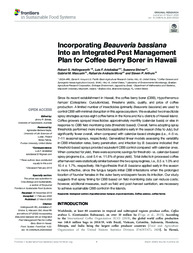Incorporating Beauveria bassiana into an integrated pest management plan for coffee berry borer in Hawaii.
Incorporating Beauveria bassiana into an integrated pest management plan for coffee berry borer in Hawaii.
Author(s): HOLLINGSWORTH, R. G.; ARISTIZÁBAL, L. F.; SHRINER, S.; MASCARIN, G. M.; MORAL, R. de A.; ARTHURS, S. P.
Summary: Since its recent establishment in Hawaii, the coffee berry borer (CBB), Hypothenemus hampei (Coleoptera: Curculionidae), threatens yields, quality, and price of coffee production. A limited number of insecticides (primarily Beauveria bassiana) are used to control CBB with minimal disruption in this agroecosystem. We evaluated two insecticide spray strategies across eight coffee farms in the Kona and Ka?u districts of Hawaii Island. Coffee growers sprayed insecticides approximately monthly (calendar basis) or else in response to CBB field monitoring data (threshold based). Overall, farms adopting spray thresholds performed more insecticide applications early in the season (May to July), but significantly fewer overall, when compared with calendar-based strategies (i.e., 4?5 vs. 7?11 seasonal sprays, respectively). Generalized linear models assessing the variability in CBB infestation rates, berry penetration, and infection by B. bassiana indicated that threshold-based sprays provided equivalent CBB control compared with calendar ones. When corrected for yield, there were economic savings for threshold- vs. calendar-based spray programs (i.e., cost 5.4 vs. 11.8% of gross yield). Total defects in processed coffee after harvest were statistically similar between the two spray regimes, i.e., 8.5 ± 1.0% and 10.4 ± 1.7%, respectively. We hypothesize that B. bassiana applied early in the season is more effective, since the fungus targets initial CBB infestations when the prolonged location of founder females in the outer berry endosperm favors its infection. Our study suggests that spray timing for CBB based on field monitoring data can reduce costs; however, additional measures, such as field and post-harvest sanitation, are necessary to achieve sustainable CBB control in the Islands.
Publication year: 2020
Types of publication: Journal article
Unit: Embrapa Environment
Observation
Some of Embrapa's publications are published as ePub files. To read them, use or download one of the following free software options to your computer or mobile device. Android: Google Play Books; IOS: iBooks; Windows and Linux: Calibre.
Access other publications
Access the Agricultural Research Database (BDPA) to consult Embrapa's full library collection and records.
Visit Embrapa Bookstore to purchase books and other publications sold by Embrapa.

